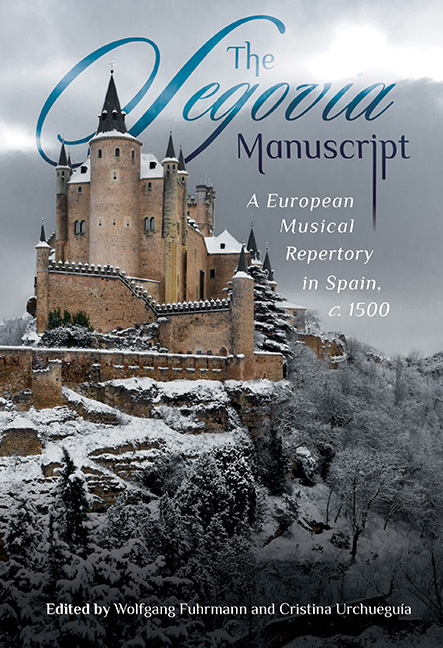Book contents
- Frontmatter
- Contents
- List of Illustrations
- Notes on Contributors
- Abbreviations
- Preambulum: A Source in Segovia
- 1 In Search of Origins: The Afterlife of a Renaissance Manuscript
- 2 New Light on the Segovia Manuscript: Watermarks, Foliation, and Ownership
- 3 Segovia's Repertoire: Attributions and Datings (with Special Reference to Jacob Obrecht)
- 4 What Was Segovia For?
- 5 The Latin Texts of the Segovia Manuscript
- 6 The Segovia Manuscript as Chansonnier
- 7 The Segovia Manuscript: Another Look at the ‘Flemish Hypothesis’
- 8 The Segovia Manuscript: Speculative Notes on the Flemish Connection
- 9 The Written Transmission of Polyphonic Song in Spain c. 1500: The Case of the Segovia Manuscript
- 10 Inventory of Segovia, Archivo Capitular de la Catedral, MS s.s.
- Bibliography
- Index of Compositions
- General Index
- Miscellaneous Endmatter
2 - New Light on the Segovia Manuscript: Watermarks, Foliation, and Ownership
Published online by Cambridge University Press: 29 March 2020
- Frontmatter
- Contents
- List of Illustrations
- Notes on Contributors
- Abbreviations
- Preambulum: A Source in Segovia
- 1 In Search of Origins: The Afterlife of a Renaissance Manuscript
- 2 New Light on the Segovia Manuscript: Watermarks, Foliation, and Ownership
- 3 Segovia's Repertoire: Attributions and Datings (with Special Reference to Jacob Obrecht)
- 4 What Was Segovia For?
- 5 The Latin Texts of the Segovia Manuscript
- 6 The Segovia Manuscript as Chansonnier
- 7 The Segovia Manuscript: Another Look at the ‘Flemish Hypothesis’
- 8 The Segovia Manuscript: Speculative Notes on the Flemish Connection
- 9 The Written Transmission of Polyphonic Song in Spain c. 1500: The Case of the Segovia Manuscript
- 10 Inventory of Segovia, Archivo Capitular de la Catedral, MS s.s.
- Bibliography
- Index of Compositions
- General Index
- Miscellaneous Endmatter
Summary
The Segovia manuscript has received more scholarly attention than any other Iberian music manuscript of the Renaissance, owing to its abundant international repertoire. Here I will present new evidence concerning the watermarks, gathering structure, foliation, and two inscriptions in Segovia relevant to its compilation process and original ownership. This evidence suggests that the compilation of the manuscript may have been more fragmented than previously thought; Segovia shares this characteristic with other Spanish manuscripts of that period and I will refer to them briefly. A comparison of the Segovia watermarks with those in Spanish incunabula will contribute to the discussion about the origins of this manuscript and the transmission of its repertoire in the context of the compilation process; in addition, and based on a hitherto unnoticed second foliation, I will propose a hypothesis about an early stage in the compilation of the manuscript. The abundant Franco-Flemish repertoire in Segovia has been traditionally explained by the journey of Philip the Fair's Flemish chapel to the Castilian court in 1501, but Spanish contact with Flemish art and music had taken place well before that date and the absence in the manuscript of music by Philip's chapelmaster, Pierre de la Rue, seems at odds with the traditional explanation.
Different hypotheses have been suggested regarding the original ownership of Segovia and its date of compilation, covering a period from after 1495 to c. 1508. However, the evidence presented here about the watermarks indicates a narrower chronological period, and the identification of the ‘Don Rodrigo’ mentioned in an inscription at the end of the manuscript connects Segovia to a Castilian noble family with strong ties to the royal family. We do not know how the manuscript ended up in the archive of Segovia Cathedral. Perhaps, as suggested by Anglés, the manuscript was saved from the 1862 fire that destroyed the Segovia Alcazar, where some music books connected to the royal family had been kept. Descriptions of music books in the 1503 inventory of the Segovia Alcazar do not match the Segovia manuscript, and thus Segovia would have been deposited at the Alcazar at a later date.
- Type
- Chapter
- Information
- The Segovia ManuscriptA European Musical Repertory in Spain, c.1500, pp. 37 - 90Publisher: Boydell & BrewerPrint publication year: 2019



